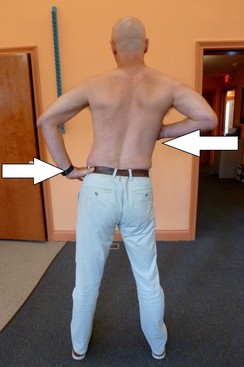McKenzie Side Glide Test
Original Editor - Rachael Lowe Top Contributors - Inga Balciuniene, Admin, Rachael Lowe, Kim Jackson, Jesse Demeester, Uchechukwu Chukwuemeka, Saimat Lachinova, Amanda Ager, Matt Huey, Carina Therese Magtibay, WikiSysop, Magdalena Hytros, Sweta Christian and Leana Louw
Introduction[edit | edit source]
Mechanical Diagnosis and Therapy (MDT) or the McKenzie Method, a classification-based system, was designed to classify patients into homogeneous subgroups to direct treatment[1]. Long, Donelson and Fung showed that a mechanical assessment could identify a large subgroup of acute, subacute, and chronic low back patients with a directional preference (an immediate, lasting improvement in pain from performing either repeated or sustained movements or positions in the sagittal plane (lumbar flexion or extension), or in the frontal plane (side glides or rotational)[2]. The McKenzie side glide test is an assessment of obstruction of movement in the frontal plane and can be provocation test for patients to determine a classification.
Purpose[edit | edit source]
The purpose of this test is to see whether the patient has a loss of motion in the frontal plane and could be utilized as a pain provocation test, and on which movement during the test this pain is present. This purpose is to understand if the patient has a possible lateral component. The assessment of this motions to determine any loss of motion or pain provocation assists in the classification of the patient[3].
Technique[edit | edit source]
The therapist stands either in front or behind the patient. The patient is to stand with their feet shoulder width apart. Instruct the patient to keep their shoulders level and to "glide" their hips to one direction without bending the knees or performing a side bending motion. The therapist can assist the patient by either stabilizing their shoulders to minimize the motion there or assist in gliding the hips to one side. The patient is instructed to go as far as they can in one direction as they can. Then the patient is to return to the starting, neutral position, and repeat to the opposite side. The therapist notes any loss of motion to either side along with any changes in the patient's symptoms.
The therapist can also add pressure to the end range to confirm that the patient has reached their end range or as a means to confirm the provocation of symptoms.
If the patient has a significant loss of motion to one side or a production of symptoms, this gives evidence that there is a lateral component and the patient may need to perform movements in the frontal plane. Remember, just because a patient has a loss of motion in the frontal plane, does not mean to always start with lateral movements. Listen to the patient's symptoms as they perform the assessment.
Treatment[edit | edit source]
The standing side glide can be utilized as a treatment in some patients. If a patient presents with a lateral shift, it is important to first correct the shift in standing. The shift is determined by the direction of the shoulders which represents the superior spinal segment. For example, if a patient is standing with their shoulders to the right and hips to the left, it is a right lateral shift.
The patient can perform the side glide by standing in a doorway with their shoulder against the door frame. The patient is instructed to glide their hip toward the door frame as far as they can go. Once at end range, back off slightly (do not allow to return to the original starting position), then glide toward the door frame. The patient is to continue for a specific number of repetitions or until the symptoms improve.
Evidence[edit | edit source]
According to McKenzie, the shift is considered to be clinically relevant when a side glide test (a frontal-plane ROM test of the trunk) alters the location or intensity of the pain reported by the patient. McKenzie, therefore, recommended the use of a two-step procedure to determine when clinically relevant lateral shifts are present. The first step requires the therapist to observe the patient's standing posture to determine whether a lateral shift is present. The second step requires the therapist to test for the clinical relevance of a lateral shift by using side-glide tests to determine whether the site or the intensity of the pain reported by the patient can be altered.[4]
Management[edit | edit source]
References[edit | edit source]
- ↑ Lam OT, Strenger DM, Chan-Fee M, Pham PT, Preuss RA, Robbins SM. Effectiveness of the McKenzie Method of Mechanical Diagnosis and Therapy for Treating Low Back Pain: Literature Review With Meta-analysis. Journal of Orthopaedic & Sports Physical Therapy. 2018;48(6):476-490.
- ↑ Long A, Delson R, Fung T. Does it matter which exercise? A randomized control trial of exercise for low back pain. Spine 2002;27(24):2529-2602.
- ↑ Santolin SM. McKenzie diagnosis and therapy in the evaluation and management of a lumbar disc derangement syndrome: A case study. J Chiropr Med, 2013;2(2): 60-65.
- ↑ Donahue MS, Riddle DL, Sullivan MS. Intertester reliability of a modified version of McKenzie's lateral shift assessments obtained on patients with low back pain. Phys Ther. 2009; 76(7): 706-16.
- ↑ Joel Laing. McKenzie Method: Extension in Lying with Lateral Modification. Available from: https://www.youtube.com/watch?v=K7EmCJR9aYk [last accessed 23/02/2020]







